In the early 1960s, lead engineer Kelly Johnson of Lockheed Martin attempted to convey to his team the level of ease at which the jet aircraft that they were tasked with designing should be able to be repaired under combat conditions using only a basic tool kit.
In describing what he was looking for, he coined a phrase that has become synonymous with straightforward, uncomplicated thinking: “keep it simple, stupid.”
This phrase – better known by its acronym KISS (not to be confused with one of our editor-in-chief’s favorite rock bands) – defines an operating principle that, according to its adherents, produces some of the best solutions possible thanks to the avoidance of superfluous complication and over-thinking.
The general assumption behind the principle is that systems work best and have the least amount of failures when they are kept as simple as possible.
Simplicity reduces failure points, as well as unintended and unplanned interactions, and allows for a much better understanding of an entire system. Therefore, adding any extra complication to a system should be avoided unless absolutely necessary.
For the people who build the SR-71 Blackbird and the new F-35 Lightning II, the “keep it simple, stupid” principle is there to ensure that some of the most complicated machines built by man aren’t any more complicated than they have to be. Given the stakes for creating reliable military aircraft, reducing unnecessary complexity is crucial, but that doesn’t mean only fighter planes can benefit from these ideas.
Any process, machine, or idea can almost certainly be made better and more effective if passed through the lens of the KISS principle. That is something that, more often than not, can seem to be missing from haute horlogerie and the ultra-complications that arise.
Now, I won’t say that is a bad thing because I absolutely love crazy mechanisms. But if you have read any of my work, you may remember that I also love clever levers: mechanical solutions that appear simple but do extraordinary things. This is where true genius lies: not in the Rube Goldberg solution of over-the-top complexity to achieve a simple goal, but in employing Occam’s razor and finding the simplest solution possible given the facts.
Watches that employ clever levers and clearly adhere to the KISS principle are always something that can turn me into a giddy fan boy, and one such piece is the Konstantin Chaykin Genius Temporis. Heck, even the name implies some genius.
Russian watch with Latin name, just go with it
Hopefully you remember the Wonder Boy Russian Watchmaker (my name for him) Konstantin Chaykin, the A.H.C.I. member who manages to fly under the mainstream radar even while producing some of the coolest and most varied watches ever designed by one man.
A while back, Chaykin released a watch that by all appearances was a definitive example of the KISS principle, the Genius Temporis: a single-handed watch.
The watch looks very classical, and by classical I mean historical – with a dial and indicator hand straight out of the nineteenth century. The only thing that really modernizes it is its very contemporary and cleanly styled case. Just gazing at the dial you could still be fooled, possibly wondering if a historical pocket watch was re-cased for the modern generation.
But that is where assumptions fall away.
A single-handed watch does not tend to display highly accurate time since it only has an hour hand which only be set approximately depending on how precise the indications marked around the edge of the dial are.
Sometimes the marks are delicate enough to display five-minute markers for an hour hand that slowly moves around the perimeter of the dial. Even so, this dial configuration is really meant to provide a sense of the time and not focus on down-to-the-minute (or down-to-the-second) time display.
But the dial layout for a single-handed watch is so clean, simple, and beautiful that many people are strongly attracted to the design if not the reality of the timekeeping. Chaykin realized that this needed to be dealt with while retaining the single-handed design.
So he followed the rules for keeping it simple – all the way to the point where only absolutely necessary complication must be added to make the watch function as intended. This, though, is still very straightforward, allowing for a very simple display.
And, finally, the lack of accuracy in the one-handed design has been addressed.
The secret in the sauce
The Genius Temporis is, in fact, not a single-handed watch. Yes, it only has one hand attached to the center arbor, but that single hand acts as two hands to indicate the hours and the minutes separately.
Sacré bleu!
“But how?” you might ask. Well, it does this on demand thanks to a couple of cams, a couple of springs, a rack, and a push button at 2 o’clock. That’s mainly it.
Pretty simple, no?
The Genius Temporis displays the hours using the large end of the solo hand pointing to the outer Roman numerals. If minutes are desired, pushing the button at 2 o’clock rapidly rotates the hand until it comes to rest, pointing with the small end at the inner minute track. Not until you release the button does it return to its normal state of indicating the hours.
The button has a decent amount of travel and must be fully depressed to properly indicate the minutes, but that is all. The simplicity of the action is very much in line with KISS principles. How it works is also rather straightforward as complications go.
The single hand is attached to an arbor extending out from a pinion in the center of the movement. That pinion is driven by a long rack that pivots at the extreme edge of the movement. This rack is in turn powered by a finger riding upon a cam wheel that takes 12 hours to make one rotation. This slowly drives the hour hand around the dial before returning when the low point of the cam comes back around.
Retrograde motion, baby
In this aspect, the hour hand is actually a twelve-hour retrograde hand since it completes its rotation and then snaps back to its starting point. But this doesn’t describe how it can also show the minutes, which is remarkably clever in its own right.
The secret is a second cam and a leaf spring. The spring does its job holding the pivoting rack against the hour cam during normal use. But when the wearer wants to know the current minutes and presses the button, the rack is pushed into that spring and away from the hour rack. As it is pushed farther away, the opposite side of the rack (and another finger) meets up with a second cam wheel that is used for indicating the minutes.
Based on very specific geometry and precise adjustment of that cam wheel, the opposite end of the “hour” hand now becomes the minute hand and indicates the current time in minutes. If you were to gently hold down the button, you could witness the minutes creep by (much faster than the hours), which actually constitutes the process for setting the time to know where the minutes actually are.
Once the button is released, the spring pushes the rack back to the other side and it contacts the hour cam and returns to indicating slow time. So the switch back and forth from hours to minutes is accomplished via a pivoting rack that meets up with two different cams to result in different hand positions.
Simple.
Reduced complexity
In the end, you have an alternating display system based on less than a handful of moving parts and very smart usage of geometry and space. This function could be made much more complexly, but it would not be any better at displaying two different indications with one single hand.
That is what makes this a great example of KISS thinking: it was made as simple as possible with everything non-essential taken away.
“Keep it simple, stupid,” as stated by Kelly Johnson of Lockheed Martin in the 1960s is a very elementary way to describe what Antoine de Saint-Exupéry said a few decades earlier in a more literary manner: “It seems that perfection is reached not when there is nothing left to add, but when there is nothing left to take away.”
I feel that Chaykin’s Genius Temporis is what Johnson and Saint-Exupéry would have been referring to had they lived to see it.
I won’t attempt to speak on their behalf, but I propose the system employed by Chaykin is incredible, clearly, among other things for the perfectly simple way of solving the task at hand. It does what it needs to in the clearest and most elegant way possible. My clever lever quota is definitely filled by this timepiece. Hopefully, you will agree.
So let’s break it down!
- Wowza Factor * 8.98 This watch wows not only with its historical looks, but also with its awesome abilities to show two different indications with one hand.
- Late Night Lust Appeal * 87.6 » 859.062 m/s2 Almost twice the force of a rocket sled, the Genius Temporis will keep you glued to your seat as you lust hard for that KISS inspired dial.
- M.G.R. * 68.1 The simplicity of this movement lies in the complexity of the problem solving. It is simply . . . awesomazing!
- Added-Functionitis * N/A Time only, but, oh, how sweet that time is. Still, you will have no use for Gotta-HAVE-That cream. (Even though I gotta-have-that!)
- Ouch Outline * 10.9 – Closing your finger in a folding knife! Unless you also accidentally squeeze down, this shouldn’t create a very, very serious problem, but it will definitely cause some hurtin’. Yet, I would take one for the team to get this watch on my wrist!
- Mermaid Moment * Press the button, press the button! If you didn’t already fall in love with the single hand layout and the style of the piece, then pressing that button will change everything. And then it will be all you can do to keep from booking the Ritz for May!
- Awesome Total * 960 Multiply the power reserve in hours (48) by the caliber specification – 01-5 (so x 1, and then x 5). Take the result and multiply by the number of cam wheels (2) and then by the number of time indications (also 2) and you are left with one very truly awesome total!
For more information, please visit www.konstantin-chaykin.com/genius_temporis.
Quick Facts Konstantin Chaykin Genius Temporis
Case: 44 mm, pink gold
Movement: manually winding Chaykin Caliber K01-5
Functions: hours, minutes
Price: €25,000
* This article was first published January 3, 2016 at In The Face Of Complexity, Simplicity Rules: The Konstantin Chaykin Genius Temporis.
You might also enjoy:
Why I Bought It: Konstantin Chaykin Joker
Why Independent Russian Watchmaker Konstantin Chaykin Is A Movie Star






















































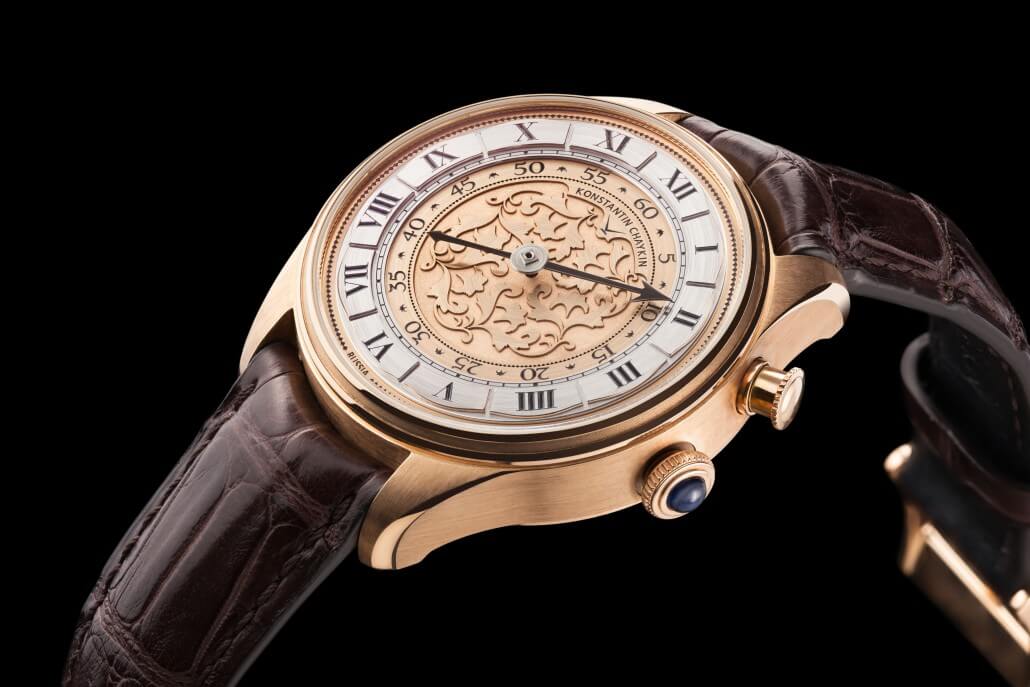

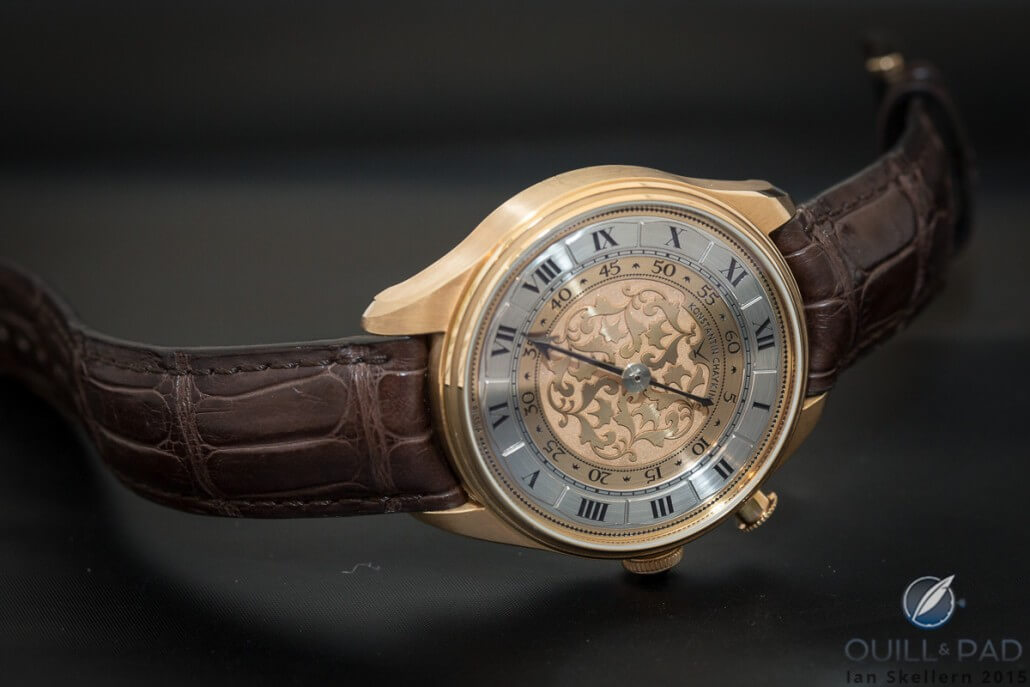
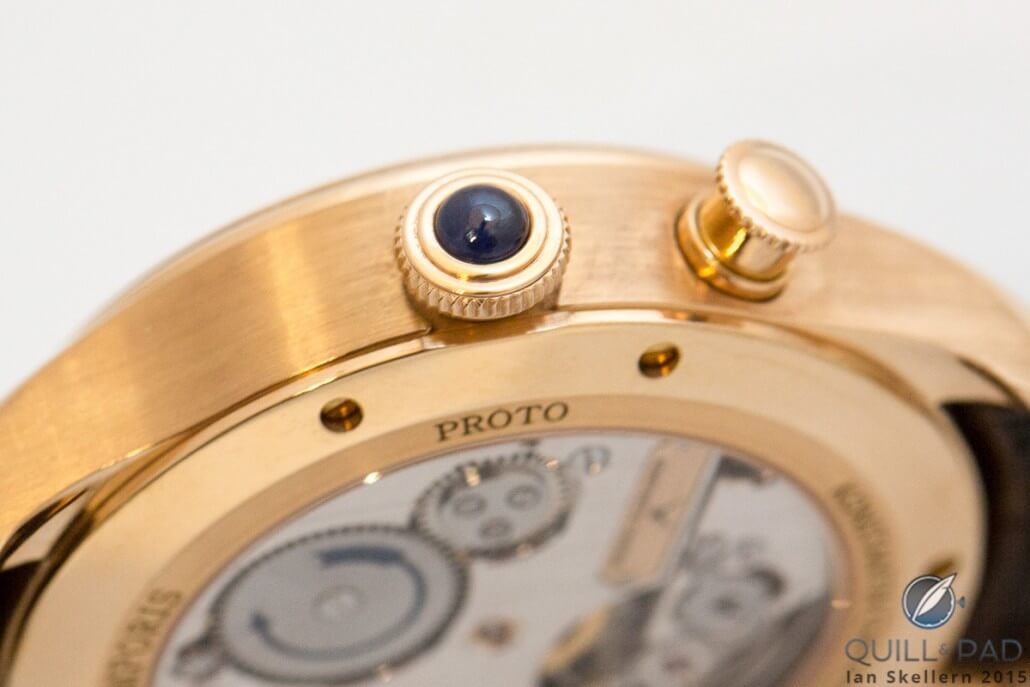
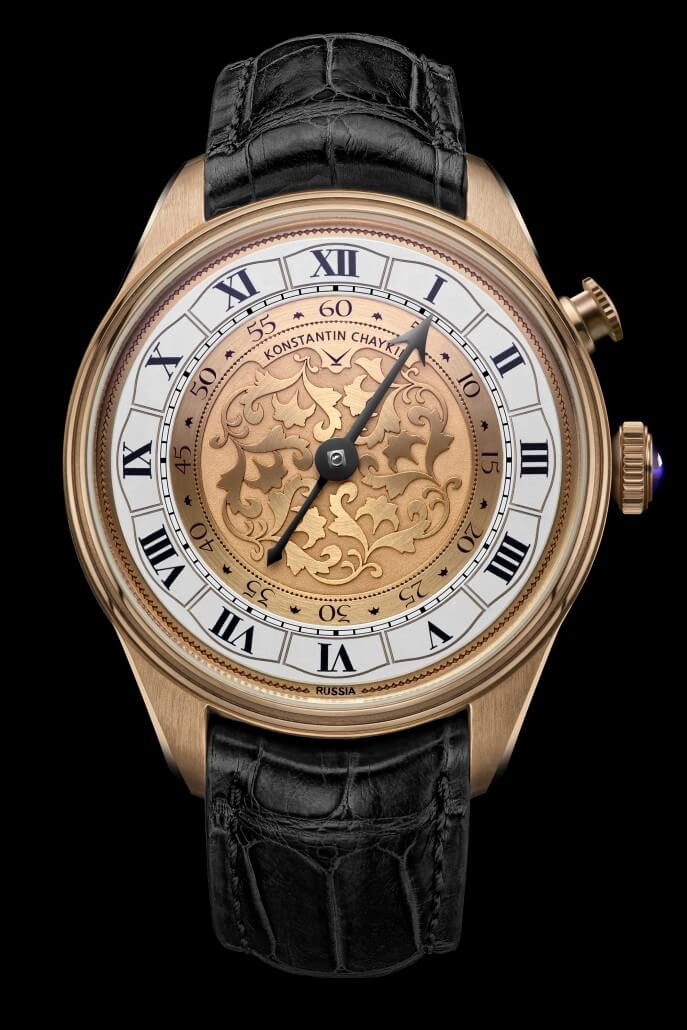
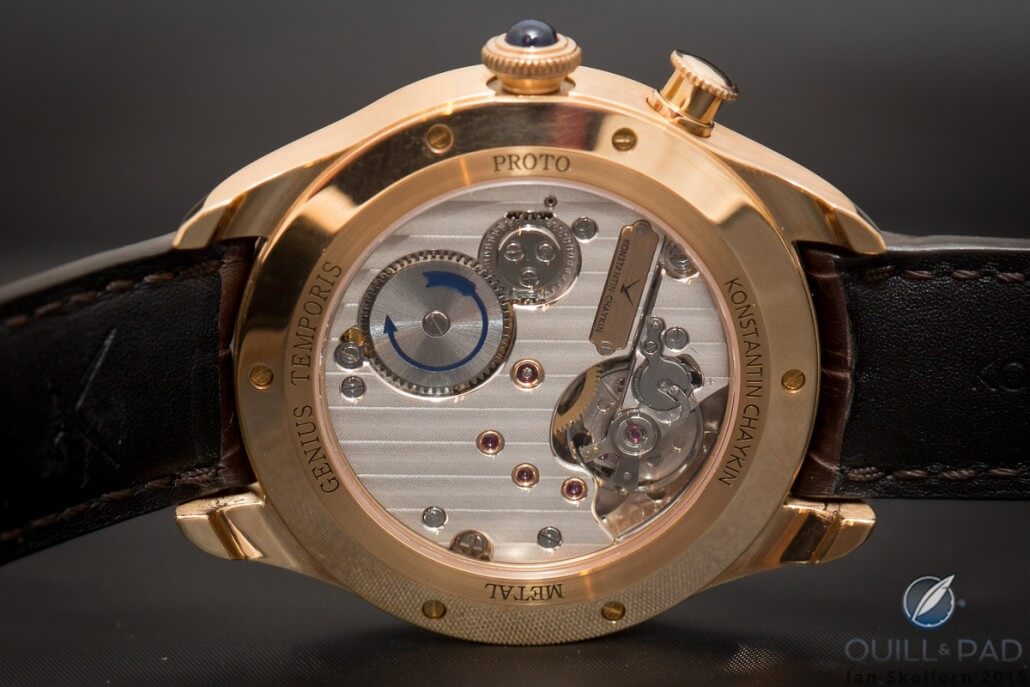
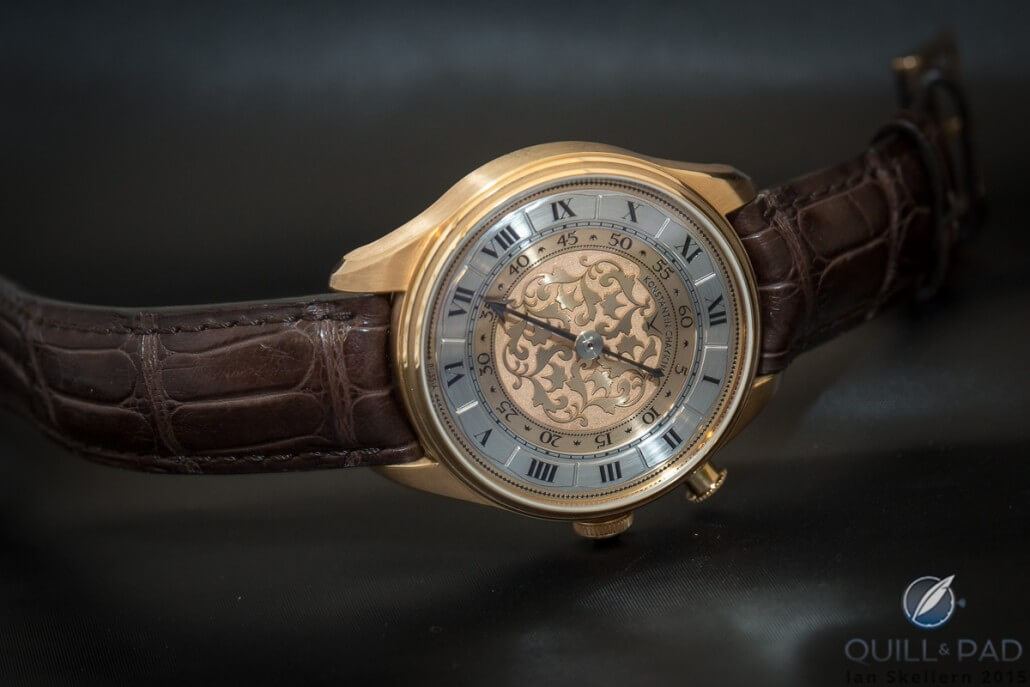
Leave a Reply
Want to join the discussion?Feel free to contribute!